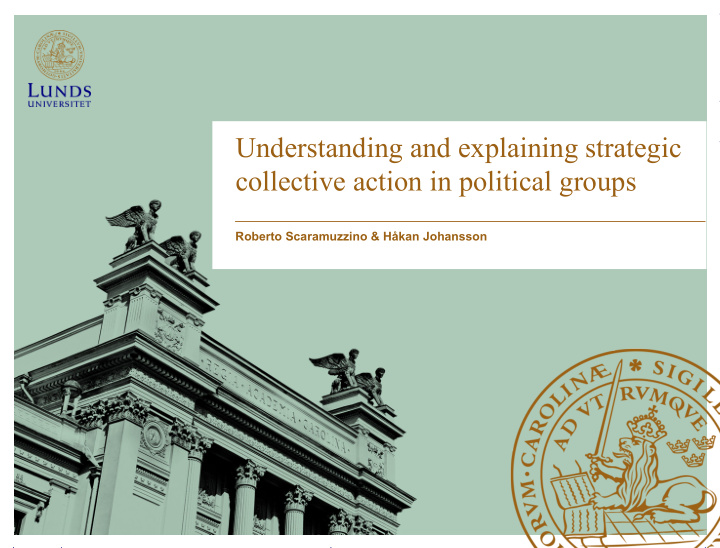



Understanding and explaining strategic collective action in political groups Roberto Scaramuzzino & Håkan Johansson
New ideals of political participation • Increased interest for alternative forms of influencing policy making processes – EU and ”participatory democracy”; Lisbon treaty contains articles about ’Citizen’s initiatives’; EU Parliament starts ’Citizens Agora’; focus on open consultation processes with NGOs • Similar trends on the national level – “Compacts”, “Agreements”, “Framework for cooperation”, “Cooperation memorandum” or “Charte des engagements réciproques” – England (1998), Italy (1999), Scotland (1998/2003), Ireland (2000), Croatia (2000), Denmark (2001), France (2001), Estonia (2002), Latvia (2005), Lithuania (2007), and Slovenia (2007) • Role model is England and its Compact (1998)
Civil dialogue in a Swedish context • On social welfare 2008-2009 • On integration 2009-2010 – Three parties: the government, the Swedish Association of Local Authorities and Regions (SKL) and the third sector. – Resulted in written agreements approved by representatives for the third sector, by SKL and by the Swedish government. – The documents have been put online and are available for all “concerned” civil society organisations to take part of and eventually sign
Two civil dialogues compared Civil dialogue on social Civil dialogue on integration welfare Starting point September 2007 January 2009 Government's Strengthen the third sectors' Eliminate the obstacles for civil aim role as critical voice and society organisations' work in the increase the number of service field of integration producing civil society organisations Participant Mostly national umbrella National and local organisations organisations organisations Agreement October 2008 May 2010 ready Initial framing A new start for the ” Swedish An implementation of the first civil model ” dialogue Signed by 53 civil society organisations 35 civil society organisations Common working group Steering group Follow-up process
Aim and research questions The aim of this paper is to understand and explain the participation of civil society organisations in the Swedish civil dialogue process between state and third sector from the point of view of their experience of interaction, opportunities and threats. The following research questions will be addressed: – How do we explain the participation of civil society organisations and their strategies? – How to understand the context of the participation (i.e. power constellation, asymmetries in resources and experience, institutional setting etc.) and what influence does it have on the process? – What influence does the civil dialogue process have on the political context of Swedish civil society organisations?
Two theoretical perspectives POS SAF Central Concept Political Context Strategic Action Field Level of analysis From Macro- to Meso-level Meso-level Focus of the model Actor in context Interaction in context Actor(s) at the centre of the Mobilising social movement All actors (individual and model collective) Opportunities (+ threats) Strategy of the actors Opportunities, threats and social determined by skills Actors' positions Protagonists Incumbents Antagonists Challengers Bystanders Governance Units Levels of analysis Interactional context SAF Configuration of actors Proximate SAFs (including institutional actors) Distant Safs Structures Direction of explanation Top-down: Top-down and bottom-up Structure-Context-Actor All directions as SAFs are interdependent
Actors or interaction? • The civil dialogue is characterised by a tension between cooperation and competition between representatives of civil society organisations • POS focuses on specific social movement (organisations) • SAF focuses on interaction between actors in the field – Such shift, from actor to interaction, gives the possibility to grasp the more complex relation among the participating actors
Which positions? • There is no consensus among the civil society organisations on the positions upheld by other actors – Some CSO might interpret the government while other stronger CSOs as the antagonist (POS) – Some CSO might see the government as ”governance units” and stronger CSOs as ”incumbents” while other CSO might see the government as ”incumbents”. All CSOs see themselves as ”challengers (SAF)
Which strategies? • The CSOs experience the dialogue process as an opportunity to affect the relation between public sector and third sector (POS & SAF) • The CSOs perceive as threats to be controlled by the government or by other stronger civil society organisations but also that the dialogue will trigger competition among civil society organisations (POS & SAF) • The ability to create a sense of struggle and convince others of being on the same side as “challengers” against certain incumbents is the most important social skill (SAF)
The civil dialogue in context • The POS approach has a stronger focus on the (political) context – It can help highlighting how the civil dialogue is a product of a change in the Swedish political context – It can offer tools to asses whether the agreement is a possible new political opportunity structure for Swedish CSOs • The interactional character of the SAF approach makes it difficult to take the broader political context in consideration. Proximate and distant SAFs broadens however the scope and enables more complex analysis.
Political participation in the civil dialogue • CSOs are able to take control over the process to be able to speak with one voice • CSOs are able to formulate a common, shared position separating their aims from the government’s framing of the dialogue • Some CSOs experience the dialogue as undemocratic as they are drawn towards a consensus against the government’s positions (cooptation by stronger CSOs) • Other CSOs find the framing of the dialogue by the government as an impediment to real influence (cooptation by government)
SAF and POS • The SAF approach enables a more interactional analysis – Who interacts with whom in the dialogue? – Which positions are upheld by the actors? – Which other SAFs influence the dialogue? • The POS approach enables a more contextualized analysis – Is the civil dialogue a new POS for Swedish CSOs? – Who are the antagonists and the bystanders? – How does the political context influence the dialogue?
Recommend
More recommend